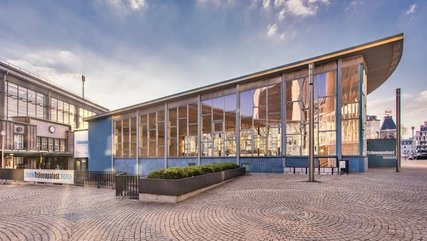
Tränenpalast
Experiences at the border of divided Berlin
Parting tears. This is what the partition of Germany meant for many Berliners and their personal stories can be found in the Tränenpalast.
Exiting the GDR. Checking in in the hall at Friedrichstraße railway station. Luggage and passport control. It sounds so rational and bureaucratic but means much more: leaving friends and family, tearful goodbyes – which is how the Tränenpalast acquired its nickname.
Immediately after the construction of the Berlin Wall, the GDR erected the check-in hall at Friedrichstraße railway station in 1962. It was used for passengers crossing from East to West Berlin. The glass and steel pavilion was very much in keeping with the architecture of the era.
Only passengers who wished to travel to West Berlin on the S-Bahn or U-Bahn could access the Tränenpalast. Policemen checked passports and visas, customs officers checked luggage and finally passports were checked thoroughly once more before onward travel was permitted.
TRÄNENPALAST. Site of German Division
The permanent exhibition "Site of German Division" documents the fate of the Tränenpalast. Interviews with contemporary witnesses, biographies and 570 original objects illustrate the history from 1962 to 1990. Where customs controls were once carried out, there are now open suitcases with memorabilia of the travellers. The feeling in the narrow corridor of the passport control is still oppressive. Numerous signs could be preserved and show the instructions at the border crossing.

Border clearance in a prestigious building
The building is prestigious, deliberately designed in an impressive modern style, hiding its function as a strictly guarded check-in hall with border troops. Screens shield the eyes of passers-by. The infrastructure of the interior of the building is well-planned, with the route to the East appearing light and, by contrast, the route to the West being dark. In the station, a jumble of signs show the way. The routes taken by East and West Germans and overseas travellers are strictly separated. These days, on entering the building, you will first see the grand staircase in the bright hall. Visit the restored inspection rooms to experience the oppressive atmosphere.
Info for families
Young people between the ages of 14 and 17 discover the exhibition on their own with the "Ihr Papiere bitte" (Your papers, please!) block. For groups of children, the workshop "Post von drüben" with unpacking of a western package is suitable. In this way the children learn more about life in the GDR and German-German cohesion in a playful way.
Information for school classes
School groups can book one-hour guided tours of the exhibition. The free guided tours are interactive and focus on the location, escape attempts, efforts to leave the country and border controls.
Practical information on how to get there
With the suburban trains S1, S2, S5, S7, S25 and S75 as well as with the subway U6 you can easily reach the station Friedrichstraße. Admission to the Tränenpalast is free. Guided tours are also free of charge for groups of ten or more, but you must book them in advance.
Opening hours
| Tuesday | |
|---|---|
| Wednesday | |
| Thursday | |
| Friday | |
| Saturday | |
| Sunday |
